Collision Avoidance and Formation Tracking Control for Heterogeneous UAV/USV Systems with Input Quantization
Abstract
1. Introduction
- (1)
- (2)
- By comparing with previous studies [38,39,40,41,42,46,47,48] that addressed input quantization in formation control systems, this paper presents a linear time-varying model that describes the quantization process, eliminating the need for quantization parameter information and simplifying the process of achieving control input quantization.
- (3)
- By comparing with previous controller design methods [43,44], this paper considers bandwidth limitations in actual navigation and potential obstacles such as buoys and successfully integrates an improved artificial potential field into the kinematic guidance process, enabling agents in a formation to perform reasonable collision avoidance and obstacle avoidance maneuvers.
2. Problem Formulation
3. Controller Design
3.1. Kinematic Controller Design
3.2. Dynamic Controller Design
3.3. Altitude Controller Design of UAV
4. Stability Analysis
4.1. Kinematic Observer Stability
4.2. Cascade System Stability
4.3. Vertical Plane Stability
5. Illustrative Example
6. Conclusions
Author Contributions
Funding
Institutional Review Board Statement
Informed Consent Statement
Data Availability Statement
Conflicts of Interest
References
- Makhsoos, A.; Mousazadeh, H.; Mohtasebi, S.S. Evaluation of some effective parameters on the energy efficiency of on-board photovoltaic array on an unmanned surface vehicle. Ships Offshore Struct. 2019, 14, 492–500. [Google Scholar] [CrossRef]
- Zhao, L.; Bai, Y.; Wang, F.; Bai, J. Path planning for autonomous surface vessels based on improved artificial fish swarm algorithm: A further study. Ships Offshore Struct. 2023, 18, 1325–1337. [Google Scholar] [CrossRef]
- Yang, Z.; Li, S.; Yu, D.; Chen, C.P. BLS-based formation control for nonlinear multi-agent systems with actuator fault and input saturation. Nonlinear Dyn. 2022, 109, 2657–2673. [Google Scholar] [CrossRef]
- Ma, L.; Wang, Y.L.; Fei, M.R.; Pan, Q.K. Cross-dimensional formation control of second-order heterogeneous multi-agent systems. ISA Trans. 2022, 127, 188–196. [Google Scholar] [CrossRef]
- Ennong, T.; Ye, L.; Teng, M.; Yulei, L.; Yueming, L.; Jian, C. Design and experiment of a sea-air heterogeneous unmanned collaborative system for rapid inspection tasks at sea. Appl. Ocean Res. 2024, 143, 103856. [Google Scholar] [CrossRef]
- Hou, H.Q.; Liu, Y.J.; Liu, L.; Lan, J. Adaptive fuzzy formation control for heterogeneous multi-agent systems using time-varying IBLFs. Nonlinear Dyn. 2023, 111, 16077–16091. [Google Scholar] [CrossRef]
- Mazare, M.; Asharioun, H.; Davoudi, E.; Mokhtari, M. Distributed finite-time neural network observer-based consensus tracking control of heterogeneous underwater vehicles. Ocean Eng. 2023, 272, 113882. [Google Scholar] [CrossRef]
- Li, X.; Yao, J. A nonlinear model predictive control method for ship path following in waves. Ships Offshore Struct. 2024, 1–14. [Google Scholar] [CrossRef]
- Wu, G.; Xu, T.; Sun, Y.; Zhang, J. Review of multiple unmanned surface vessels collaborative search and hunting based on swarm intelligence. Int. J. Adv. Robot. Syst. 2022, 19, 17298806221091885. [Google Scholar] [CrossRef]
- Liu, C.; Wang, Y. Neural adaptive performance guaranteed formation control for USVs with event-triggered quantized inputs. Ships Offshore Struct. 2024, 1–13. [Google Scholar] [CrossRef]
- Ma, S.; Guo, W.; Song, R.; Liu, Y. Unsupervised learning based coordinated multi-task allocation for unmanned surface vehicles. Neurocomputing 2021, 420, 227–245. [Google Scholar] [CrossRef]
- Sun, Z.; Sun, H.; Li, P.; Zou, J. Self-organizing cooperative pursuit strategy for multi-USV with dynamic obstacle ships. J. Mar. Sci. Eng. 2022, 10, 562. [Google Scholar] [CrossRef]
- Liang, Q.; Huang, H.; Huang, B.; Hu, S.; Yang, C. Three-dimensional deployment strategy for a multi-BWBUG cooperative system at deep depths. Ships Offshore Struct. 2024, 1–19. [Google Scholar] [CrossRef]
- Cui, Y.; Peng, L.; Li, H. Filtered probabilistic model predictive control-based reinforcement learning for unmanned surface vehicles. IEEE Trans. Ind. Inform. 2022, 18, 6950–6961. [Google Scholar] [CrossRef]
- Ning, J.; Ma, Y.; Liu, L.; Li, T. Fuzzy course tracking control of an unmanned surface vehicle with event-triggered mechanism and input quantization. Ocean Eng. 2023, 288, 115704. [Google Scholar] [CrossRef]
- Deng, Z.; Wang, Z.; Shen, W. Formation control of unmanned surface vehicles with position estimation algorithm. Mech. Sci. Technol. Aerosp. Eng. 2022, 41, 623–633. [Google Scholar]
- Zhang, J.; Yan, J.; Zhang, P. Multi-UAV formation control based on a novel back-stepping approach. IEEE Trans. Veh. Technol. 2020, 69, 2437–2448. [Google Scholar] [CrossRef]
- Do, H.T.; Hua, H.; Nguyen, M.T.; Nguyen, V.-C.; Nguyen, H.; Nga, N.T.T.; Nguyen, N.T. Formation control algorithms for multiple-uavs: A comprehensive survey. EAI Endorsed Trans. Ind. Netw. Intell. Syst. 2021, 8, e3. [Google Scholar] [CrossRef]
- Yan, M.-d.; Zhu, X.; Zhang, X.-x.; Qu, Y.-h. Consensus-based three-dimensionalmulti-UAV formation control strategy with high precision. Front. Inf. Technol. Electron. Eng. 2017, 18, 968–977. [Google Scholar] [CrossRef]
- Ke, C.; Chen, H.; Xie, L. Cross-Domain Fixed-Time Formation Control for an Air-Sea Heterogeneous Unmanned System with Disturbances. J. Mar. Sci. Eng. 2023, 11, 1336. [Google Scholar] [CrossRef]
- Haoliang, W.; Chenyang, Y.; Liyu, L.; Dan, W.; Zhouhua, P. Cooperative path following control of UAV and USV cluster for maritime search and rescue. Chin. J. Ship Res. 2022, 17, 157–165. [Google Scholar]
- Xue, K.; Wu, T. Distributed consensus of USVs under heterogeneous UAV-USV multi-agent systems cooperative control scheme. J. Mar. Sci. Eng. 2021, 9, 1314. [Google Scholar] [CrossRef]
- Lui, D.G.; Petrillo, A.; Santini, S. Leader tracking control for heterogeneous uncertain nonlinear multi-agent systems via a distributed robust adaptive PID strategy. Nonlinear Dyn. 2022, 108, 363–378. [Google Scholar] [CrossRef]
- Zhen, Q.; Wan, L.; Li, Y.; Jiang, D. Formation control of a multi-AUVs system based on virtual structure and artificial potential field on SE(3). Ocean Eng. 2022, 253, 111148. [Google Scholar] [CrossRef]
- Carreras, M.; Batlle, J.; Ridao, P.; Roberts, G. An overview on behaviour-based methods for AUV control. IFAC Proc. Vol. 2000, 33, 141–146. [Google Scholar] [CrossRef]
- Karkoub, M.; Wang, H.; Wu, T.S. Distributed Newton and Quasi-Newton methods for formation control of autonomous vehicles. Ships Offshore Struct. 2020, 15, 61–74. [Google Scholar] [CrossRef]
- Yu, H.; Zhang, S. Collaborative task decision-making of multi-UUV in dynamic environments based on deep reinforcement learning. Sips Offshore Struct. 2024, 1–11. [Google Scholar] [CrossRef]
- Li, M.; Chen, Y.; Hu, K.; Pan, C.; Mao, Z. Observer-based decentralized fuzzy control for connected nonlinear vehicle systems. Nonlinear Dyn. 2023, 111, 7321–7337. [Google Scholar] [CrossRef]
- Glotzbach, T.; Schneider, M.; Otto, P. Cooperative line of sight target tracking for heterogeneous unmanned marine vehicle teams: From theory to practice. Robot. Auton. Syst. 2015, 67, 53–60. [Google Scholar] [CrossRef]
- Lu, E.; Tian, Z.; Xu, L.; Ma, Z.; Luo, C. Observer-based robust cooperative formation tracking control for multiple combine harvesters. Nonlinear Dyn. 2023, 111, 15109–15125. [Google Scholar] [CrossRef]
- Dong, Z.; Zhang, Z.; Qi, S.; Zhang, H.; Li, J.; Liu, Y. Autonomous cooperative formation control of underactuated USVs based on improved MPC in complex ocean environment. Ocean Eng. 2023, 270, 113633. [Google Scholar] [CrossRef]
- Zhang, H.; Zhang, X.; Xu, H.; Soares, C.G. Heterogeneous cooperative trajectory tracking control between surface and underwater unmanned vehicles. Ocean Eng. 2024, 301, 117137. [Google Scholar] [CrossRef]
- Wang, H.; Tian, Y.; Xu, H. Neural adaptive command filtered control for cooperative path following of multiple underactuated autonomous underwater vehicles along one path. IEEE Trans. Syst. Man Cybern. Syst. 2021, 52, 2966–2978. [Google Scholar] [CrossRef]
- Liu, H.; Weng, P.; Tian, X.; Mai, Q. Distributed adaptive fixed-time formation control for UAV-USV heterogeneous multi-agent systems. Ocean Eng. 2023, 267, 113240. [Google Scholar] [CrossRef]
- Li, S.; Wang, X.; Wang, S.; Zhang, Y. Distributed bearing-only formation control for uav-uwsv heterogeneous system. Drones 2023, 7, 124. [Google Scholar] [CrossRef]
- Huang, D.; Li, H.; Li, X. Formation of generic UAVs-USVs system under distributed model predictive control scheme. IEEE Trans. Circuits Syst. II Express Briefs 2020, 67, 3123–3127. [Google Scholar] [CrossRef]
- Li, Y.; Liu, M.; Lian, J.; Guo, Y. Collaborative optimal formation control for heterogeneous multi-agent systems. Entropy 2022, 24, 1440. [Google Scholar] [CrossRef]
- Weng, P.; Tian, X.; Liu, H.; Mai, Q. Distributed edge-based event-triggered optimal formation control for air-sea heterogeneous multiagent systems. Ocean Eng. 2023, 288, 116066. [Google Scholar] [CrossRef]
- Yuan, Z.; Zhao, L.; Tian, S.; Zhang, D. A maritime image dehazing algorithm based on improved VQGAN. Ships Offshore Struct. 2024, 1–15. [Google Scholar] [CrossRef]
- Liu, C. Neural-network-based distributed formation tracking control of marine vessels with heterogeneous hydrodynamics. IEEE Access 2019, 7, 150141–150149. [Google Scholar] [CrossRef]
- Lv, C.; Chen, J.; Yu, H.; Chi, J.; Yang, Z. Adaptive NN state error PCH trajectory tracking control for unmanned surface vessel with uncertainties and input saturation. Asian J. Control 2023, 25, 3903–3919. [Google Scholar] [CrossRef]
- Choi, Y.H.; Yoo, S.J. Distributed quantized feedback design strategy for adaptive consensus tracking of uncertain strict-feedback nonlinear multiagent systems with state quantizers. IEEE Trans. Cybern. 2021, 52, 7069–7083. [Google Scholar] [CrossRef] [PubMed]
- Zhu, Z.; Yin, Y.; Lyu, H. Automatic collision avoidance algorithm based on route-plan-guided artificial potential field method. Ocean Eng. 2023, 271, 113737. [Google Scholar] [CrossRef]
- Zhu, Z.; Lyu, H.; Zhang, J.; Yin, Y. An efficient ship automatic collision avoidance method based on modified artificial potential field. J. Mar. Sci. Eng. 2022, 10, 3. [Google Scholar] [CrossRef]
- Hao, L.Y.; Zhang, H.; Guo, G.; Li, H. Quantized sliding mode control of unmanned marine vehicles: Various thruster faults tolerated with a unified model. IEEE Trans. Syst. Man Cybern. Syst. 2019, 51, 2012–2026. [Google Scholar] [CrossRef]
- Fang, X.; Zhou, J.; Wen, G. Location game of multiple unmanned surface vessels with quantized communications. IEEE Trans. Circuits Syst. II Express Briefs 2021, 69, 1322–1326. [Google Scholar] [CrossRef]
- Xiong, S.; Wu, Q.; Wang, Y. Distributed Coordination of Heterogeneous Multi-agent Systems with Dynamic Quantization and L 2- L Control. Int. J. Control Autom. Syst. 2020, 18, 2468–2481. [Google Scholar] [CrossRef]
- Zheng, B.C.; Yang, G.H. Quantized output feedback stabilization of uncertain systems with input nonlinearities via sliding mode control. Int. J. Robust Nonlinear Control 2014, 24, 228–246. [Google Scholar] [CrossRef]
- Hamidaoui, M.; Talhaoui, M.Z.; Li, M.; Midoun, M.A.; Haouassi, S.; Mekkaoui, D.E.; Smaili, A.; Cherraf, A.; Benyoub, F.Z. Survey of Autonomous Vehicles’ Collision Avoidance Algorithms. Sensors 2025, 25, 395. [Google Scholar] [CrossRef]
- Huang, S.; Teo, R.S.H.; Tan, K.K. Collision avoidance of multi unmanned aerial vehicles: A review. Annu. Rev. Control 2019, 48, 147–164. [Google Scholar] [CrossRef]
- Peng, Z.; Wang, J.; Wang, D. Distributed maneuvering of autonomous surface vehicles based on neurodynamic optimization and fuzzy approximation. IEEE Trans. Control Syst. Technol. 2017, 26, 1083–1090. [Google Scholar] [CrossRef]
- Peng, Z.; Wang, J.; Wang, D.; Han, Q.L. An overview of recent advances in coordinated control of multiple autonomous surface vehicles. IEEE Trans. Ind. Inform. 2020, 17, 732–745. [Google Scholar] [CrossRef]
- Peng, Z.; Wang, D.; Wang, J. Data-driven adaptive disturbance observers for model-free trajectory tracking control of maritime autonomous surface ships. IEEE Trans. Neural Netw. Learn. Syst. 2021, 32, 5584–5594. [Google Scholar] [CrossRef]
- Ning, J.; Li, T.; Chen, C.P. Neuro-adaptive distributed formation tracking control of under-actuated unmanned surface vehicles with input quantization. Ocean Eng. 2022, 265, 112492. [Google Scholar] [CrossRef]
- Ning, J.; Ma, Y.; Li, T.; Chen, C.P.; Tong, S. Event-triggered Based Trajectory Tracking Control of Under-actuated Unmanned Surface Vehicle with State and Input Quantization. IEEE Trans. Intell. Veh. 2023, 9, 3127–3139. [Google Scholar] [CrossRef]
- Gu, N.; Wang, D.; Peng, Z.; Liu, L. Observer-based finite-time control for distributed path maneuvering of underactuated unmanned surface vehicles with collision avoidance and connectivity preservation. IEEE Trans. Syst. Man Cybern. Syst. 2019, 51, 5105–5115. [Google Scholar] [CrossRef]
- Peng, Z.; Gu, N.; Zhang, Y.; Liu, Y.; Wang, D.; Liu, L. Path-guided time-varying formation control with collision avoidance and connectivity preservation of under-actuated autonomous surface vehicles subject to unknown input gains. Ocean Eng. 2019, 191, 106501. [Google Scholar] [CrossRef]
- Peng, Z.; Wang, D.; Li, T.; Han, M. Output-feedback cooperative formation maneuvering of autonomous surface vehicles with connectivity preservation and collision avoidance. IEEE Trans. Cybern. 2019, 50, 2527–2535. [Google Scholar] [CrossRef]
- Wang, W.; Wang, Y.; Li, T. Distributed Formation Maneuvering Quantized Control of Under-Actuated Unmanned Surface Vehicles with Collision and Velocity Constraints. J. Mar. Sci. Eng. 2024, 12, 848. [Google Scholar] [CrossRef]
- Liu, L.; Wang, D.; Peng, Z.; Han, Q.L. Distributed path following of multiple under-actuated autonomous surface vehicles based on data-driven neural predictors via integral concurrent learning. IEEE Trans. Neural Netw. Learn. Syst. 2021, 32, 5334–5344. [Google Scholar] [CrossRef]
- Liu, S.; Jiang, B.; Mao, Z.; Ma, Y. Adaptive fault-tolerant formation control of heterogeneous multi-agent systems under directed communication topology. Sensors 2022, 22, 6212. [Google Scholar] [CrossRef] [PubMed]
- Peng, Z.; Liu, L.; Wang, J. Output-feedback flocking control of multiple autonomous surface vehicles based on data-driven adaptive extended state observers. IEEE Trans. Cybern. 2020, 51, 4611–4622. [Google Scholar] [CrossRef]

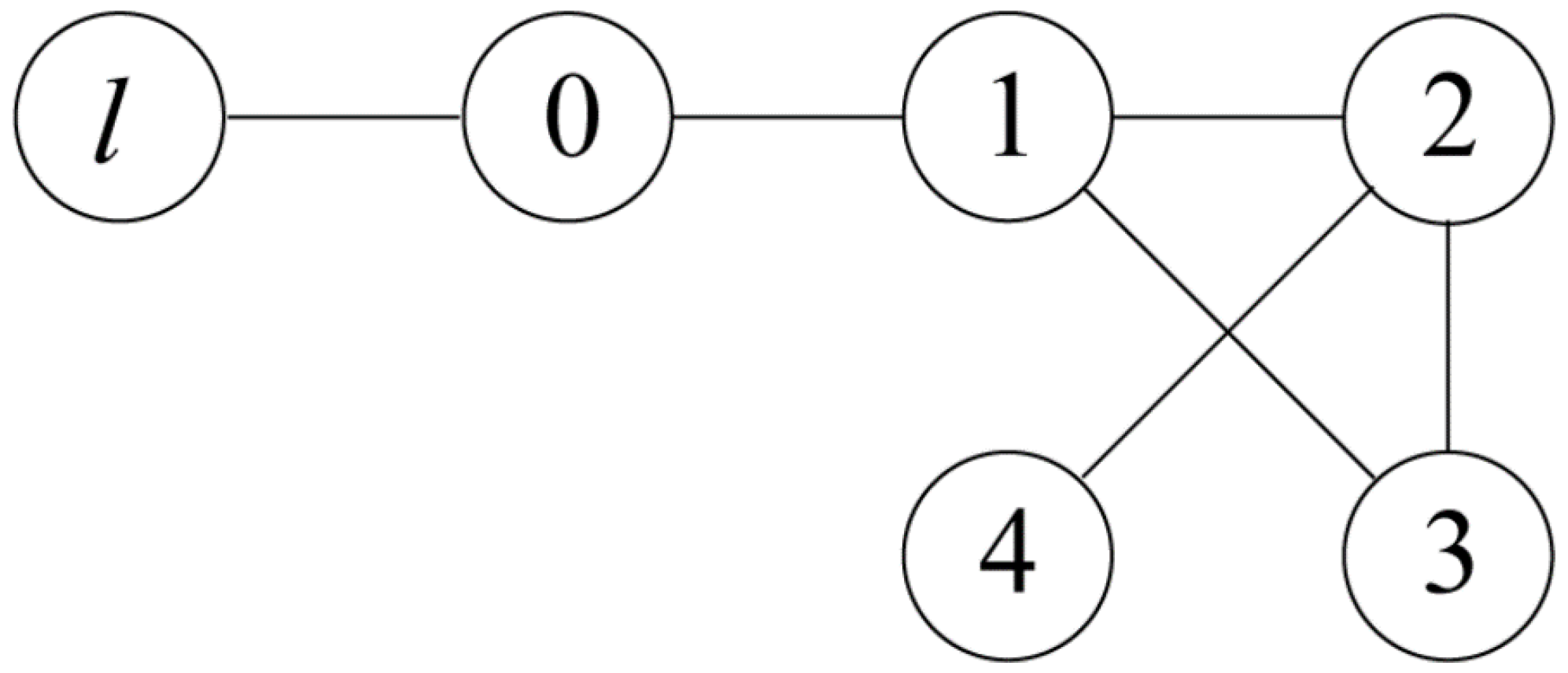

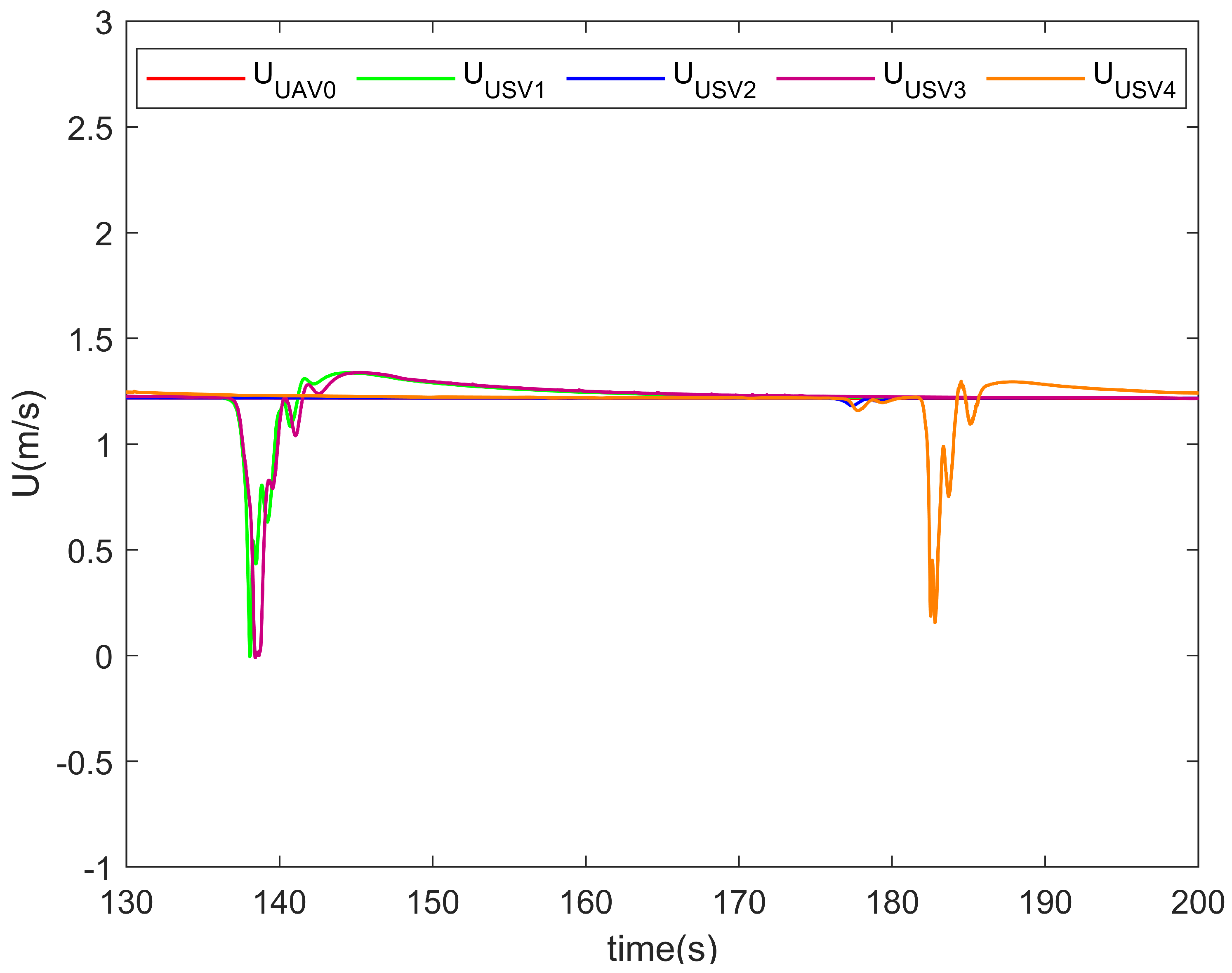
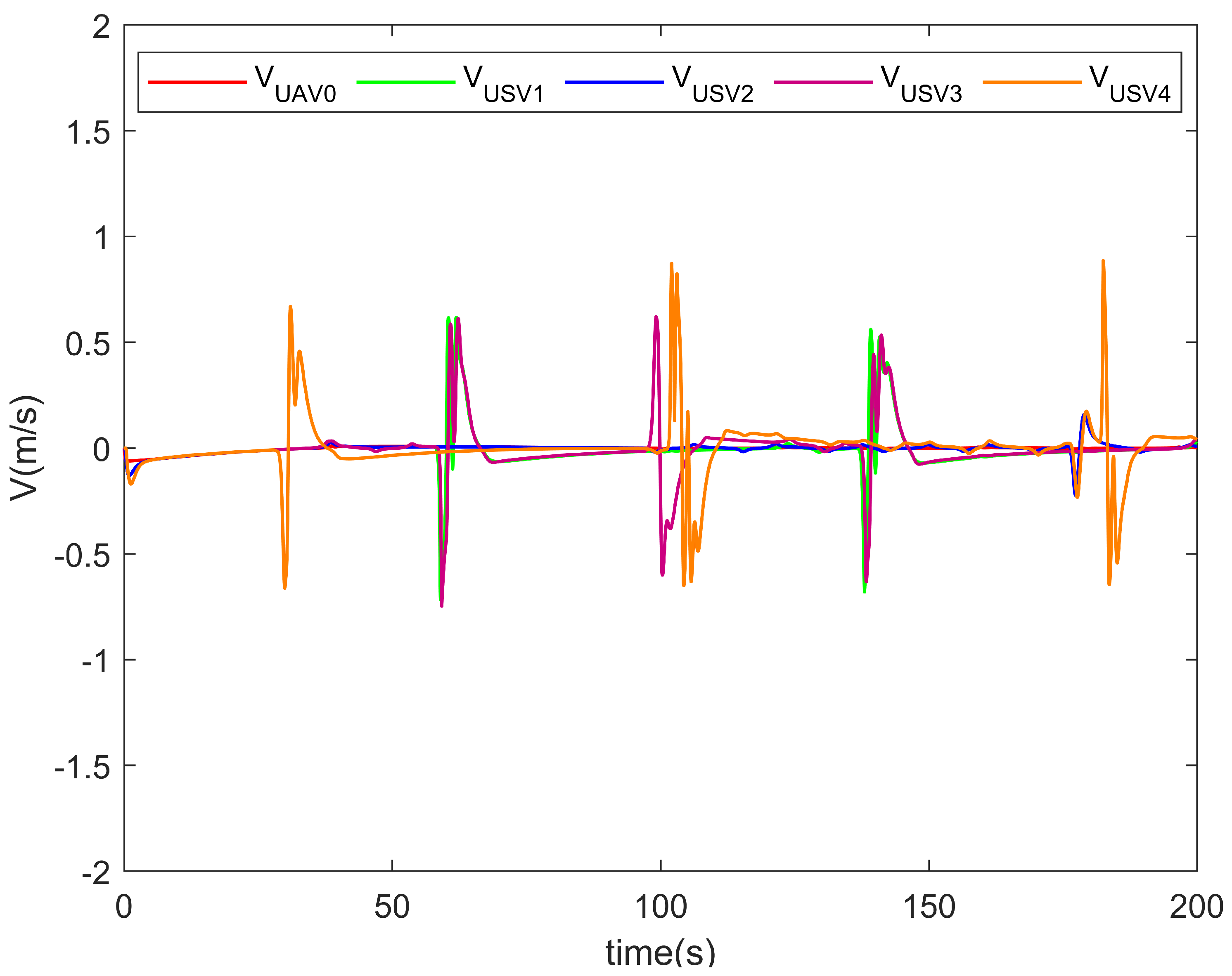



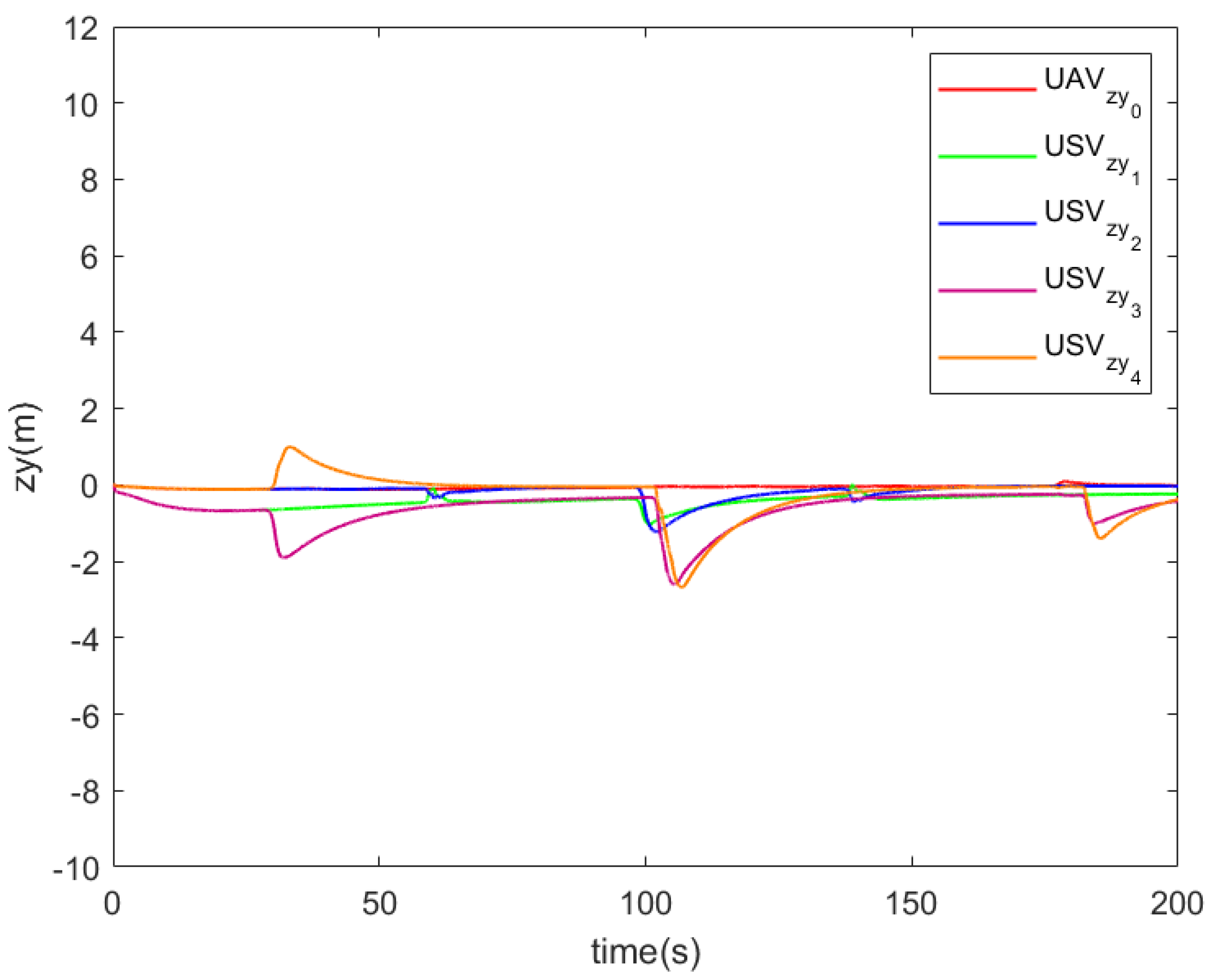
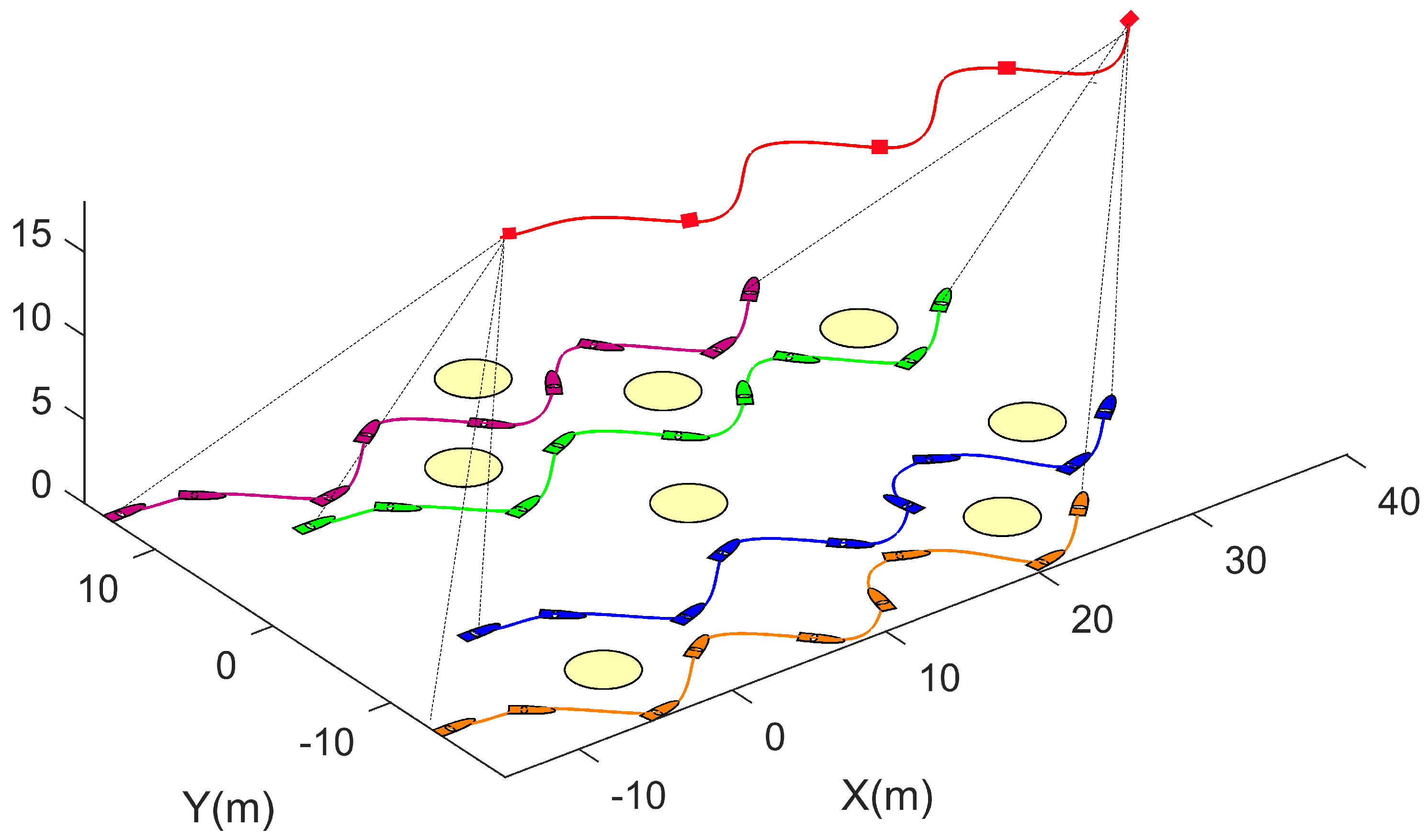
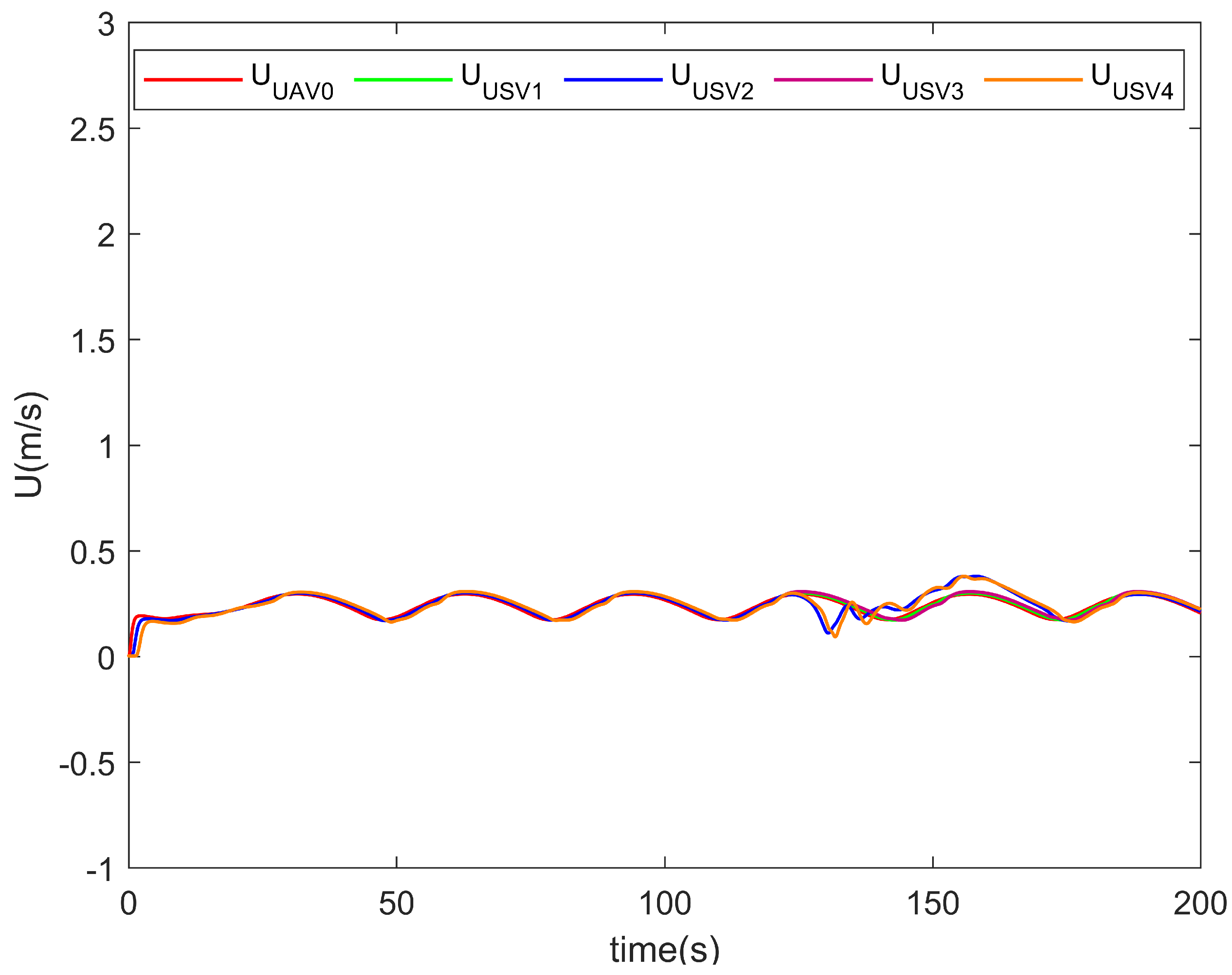
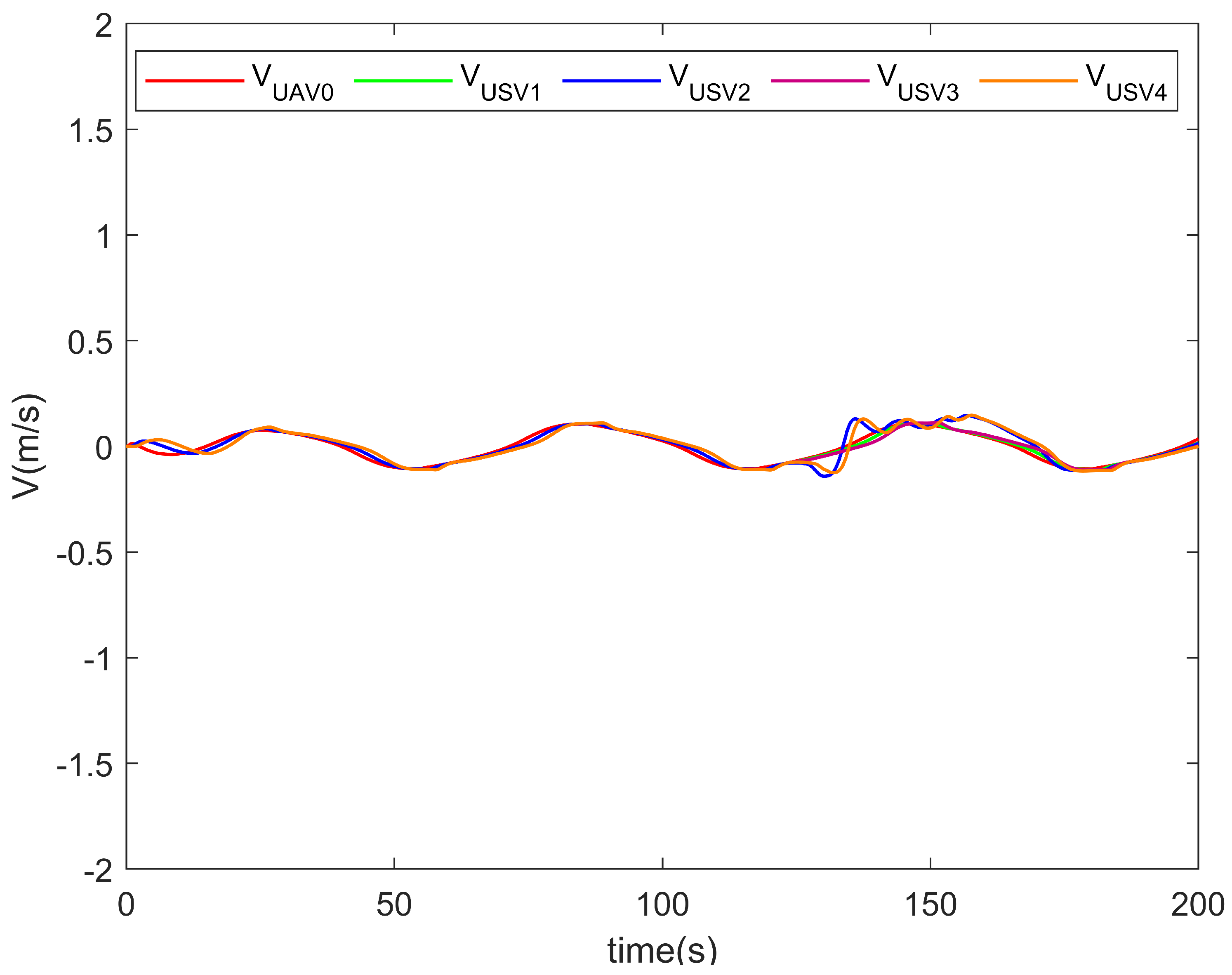
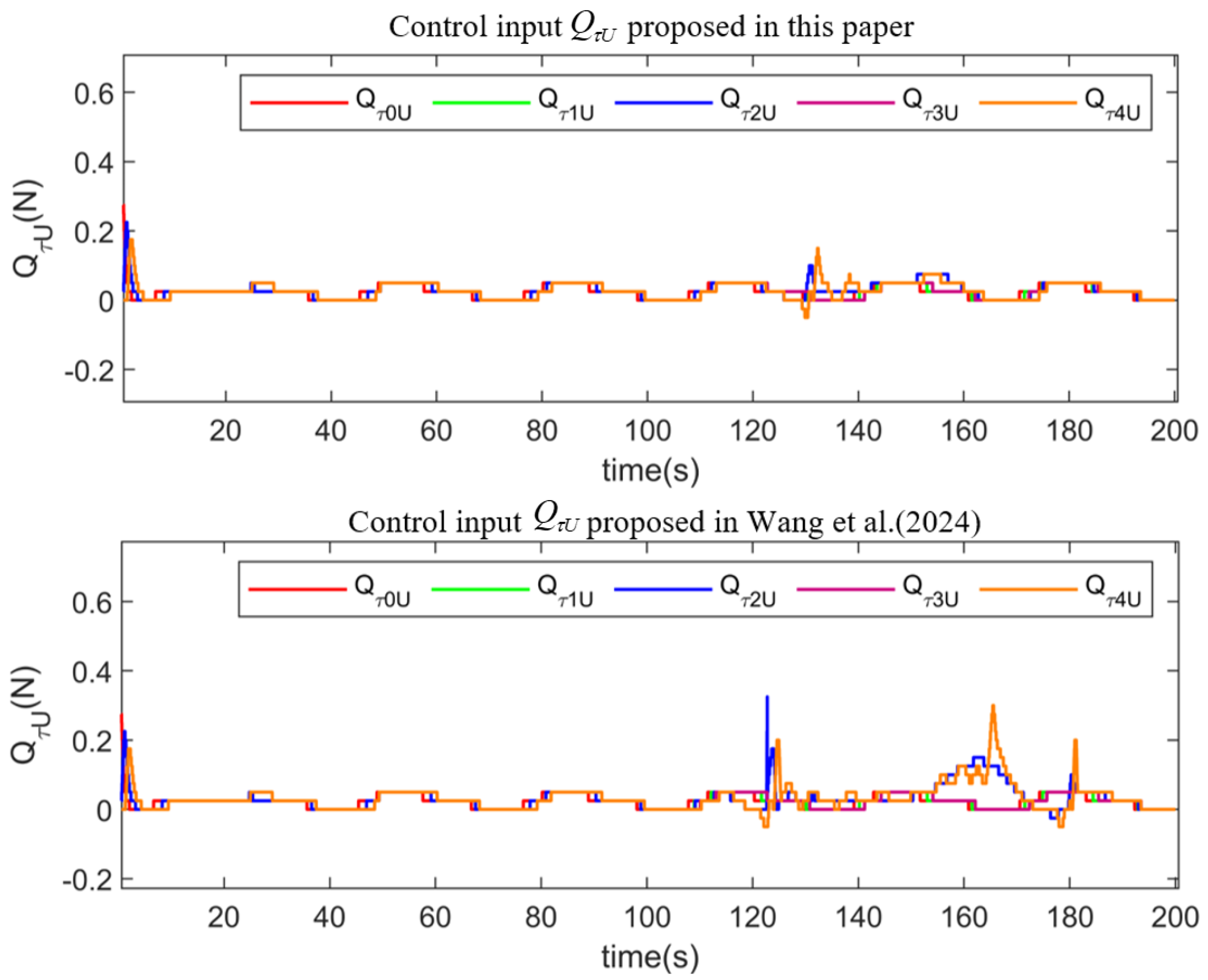
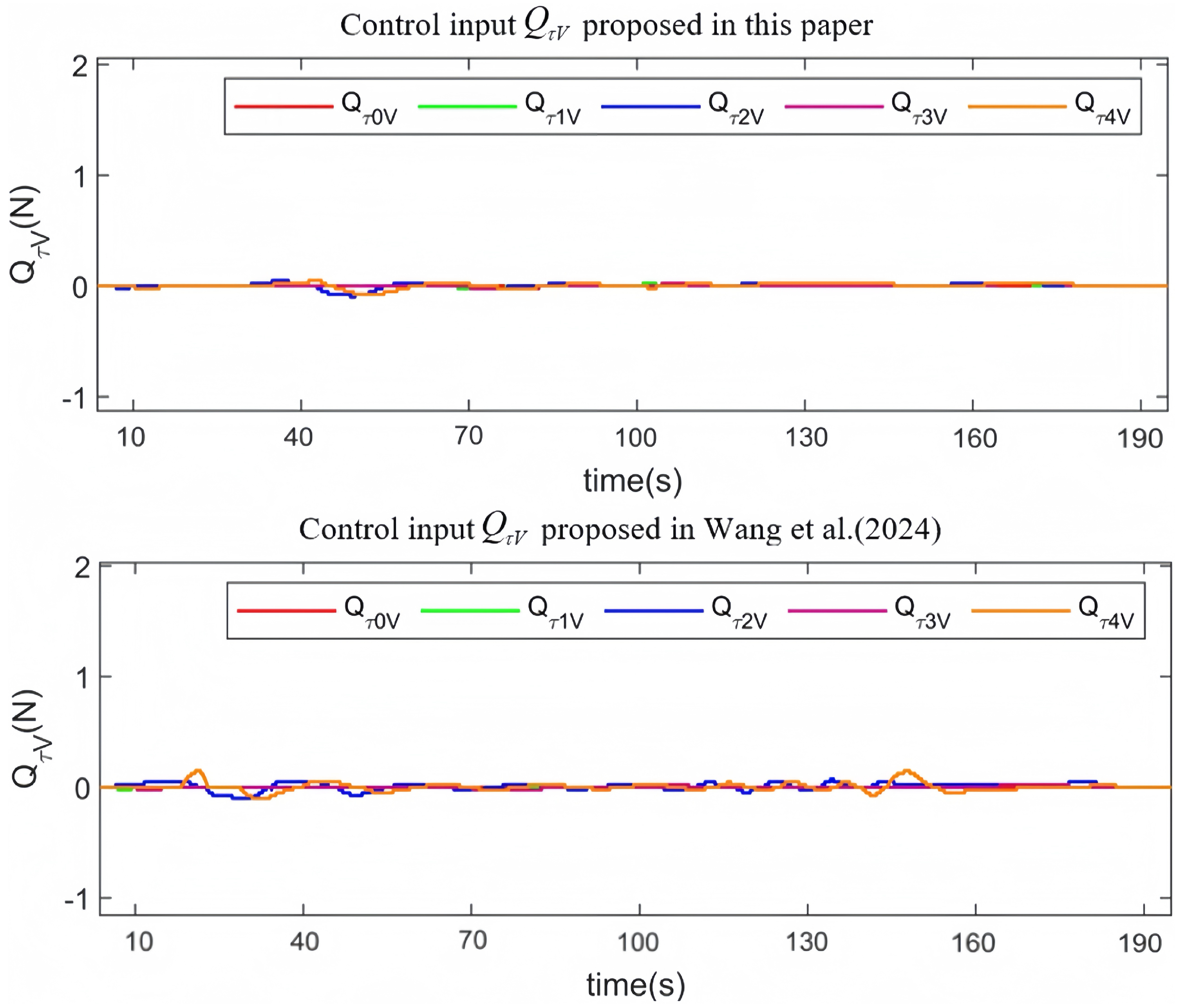
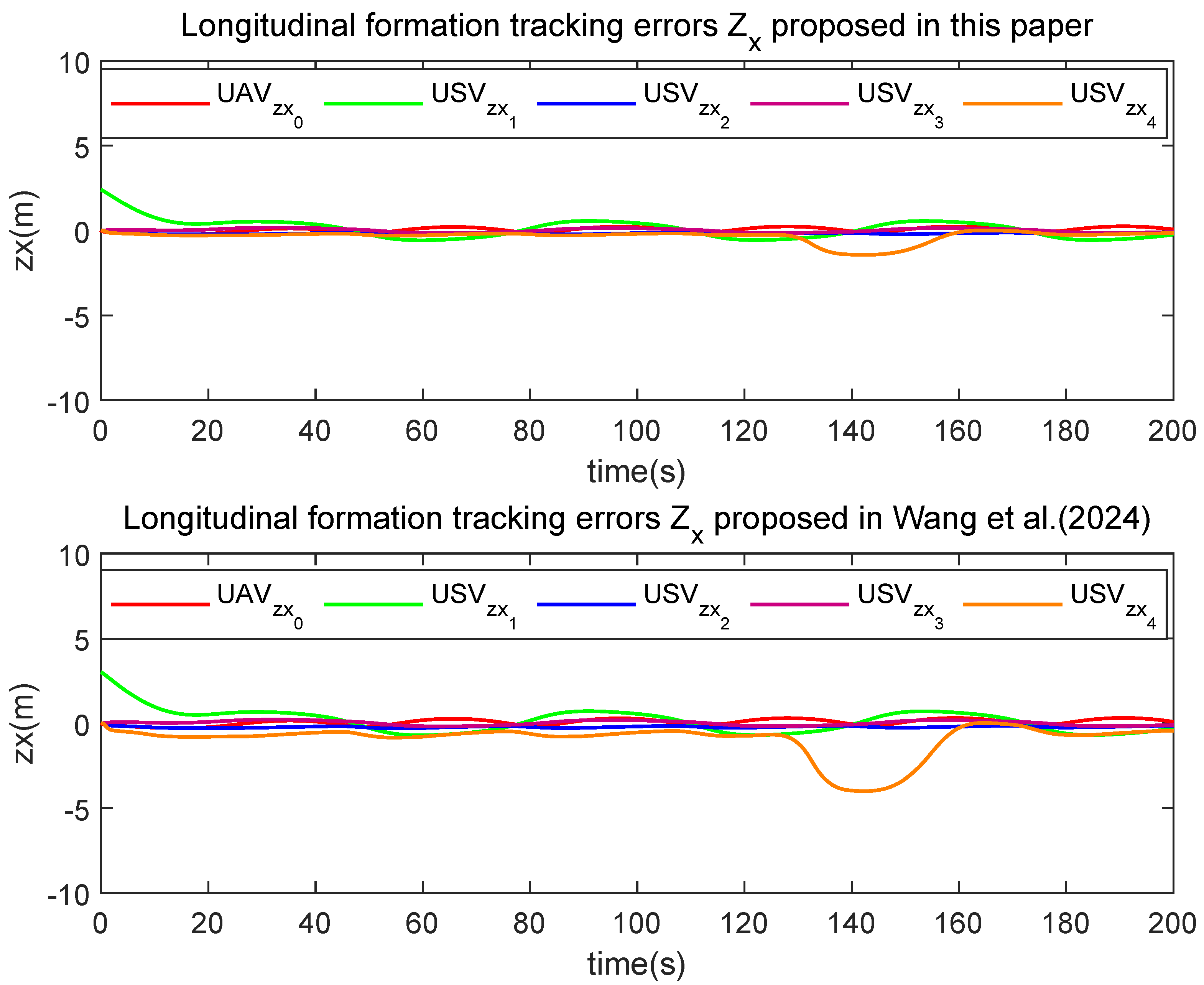
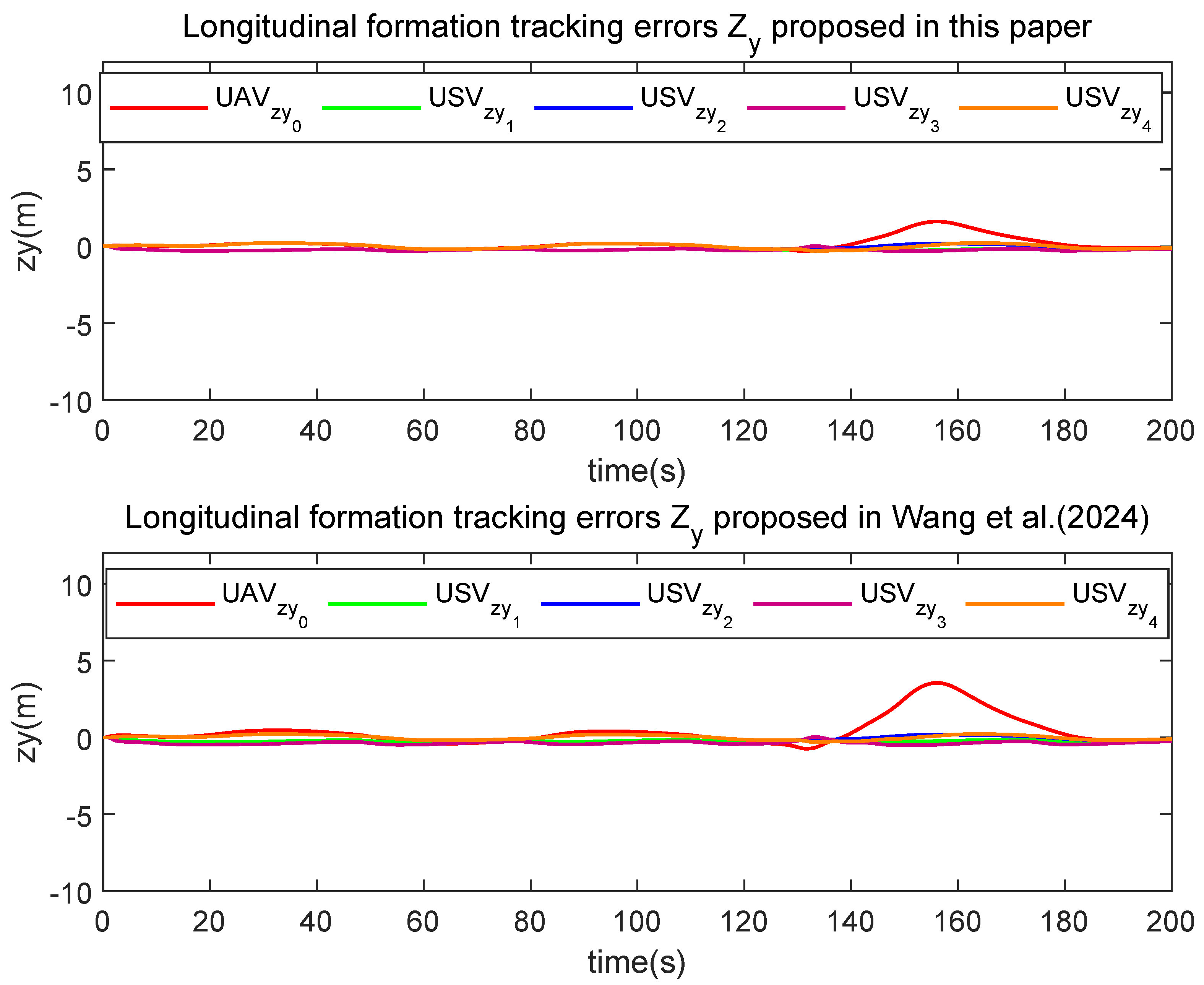
| Parameter | Value | Unit |
|---|---|---|
| 25.8 | kg | |
| g | 9.8 | |
| 1.5 | ||
| 0.012 | ||
| kg | ||
| 33.8 | kg | |
| 2.76 | kg | |
| 0.725 | ||
| −1.9 | ||
Disclaimer/Publisher’s Note: The statements, opinions and data contained in all publications are solely those of the individual author(s) and contributor(s) and not of MDPI and/or the editor(s). MDPI and/or the editor(s) disclaim responsibility for any injury to people or property resulting from any ideas, methods, instructions or products referred to in the content. |
© 2025 by the authors. Licensee MDPI, Basel, Switzerland. This article is an open access article distributed under the terms and conditions of the Creative Commons Attribution (CC BY) license (https://creativecommons.org/licenses/by/4.0/).
Share and Cite
Wang, H.; Li, W.; Ning, J. Collision Avoidance and Formation Tracking Control for Heterogeneous UAV/USV Systems with Input Quantization. Actuators 2025, 14, 309. https://doi.org/10.3390/act14070309
Wang H, Li W, Ning J. Collision Avoidance and Formation Tracking Control for Heterogeneous UAV/USV Systems with Input Quantization. Actuators. 2025; 14(7):309. https://doi.org/10.3390/act14070309
Chicago/Turabian StyleWang, Hongyu, Wei Li, and Jun Ning. 2025. "Collision Avoidance and Formation Tracking Control for Heterogeneous UAV/USV Systems with Input Quantization" Actuators 14, no. 7: 309. https://doi.org/10.3390/act14070309
APA StyleWang, H., Li, W., & Ning, J. (2025). Collision Avoidance and Formation Tracking Control for Heterogeneous UAV/USV Systems with Input Quantization. Actuators, 14(7), 309. https://doi.org/10.3390/act14070309






